Citroen GRAND C4 PICASSO 2017 2.G Owner's Manual
Manufacturer: CITROEN, Model Year: 2017, Model line: GRAND C4 PICASSO, Model: Citroen GRAND C4 PICASSO 2017 2.GPages: 527, PDF Size: 12.91 MB
Page 261 of 527
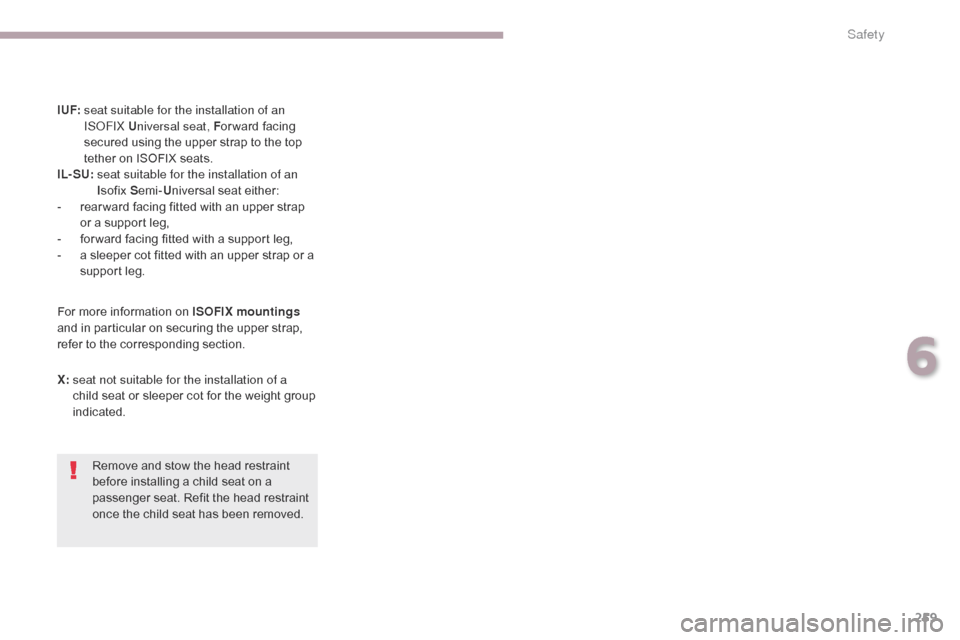
259
C4-Picasso-II_en_Chap06_securite_ed02-2016
I UF: seat suitable for the installation of an
ISOFIX U niversal seat, F or ward facing
secured using the upper strap to the top
tether on ISOFIX seats.
IL- SU:
s
eat suitable for the installation of an
I sofix S emi-Universal seat either:
-
r
ear ward facing fitted with an upper strap
or a support leg,
-
f
or ward facing fitted with a support leg,
-
a s
leeper cot fitted with an upper strap or a
support leg.
Remove and stow the head restraint
before installing a child seat on a
passenger seat. Refit the head restraint
once the child seat has been removed.
For more information on ISOFIX mountings
and in particular on securing the upper strap,
refer to the corresponding section.
X:
s
eat not suitable for the installation of a
child seat or sleeper cot for the weight group
indicated.
6
Safety
Page 262 of 527
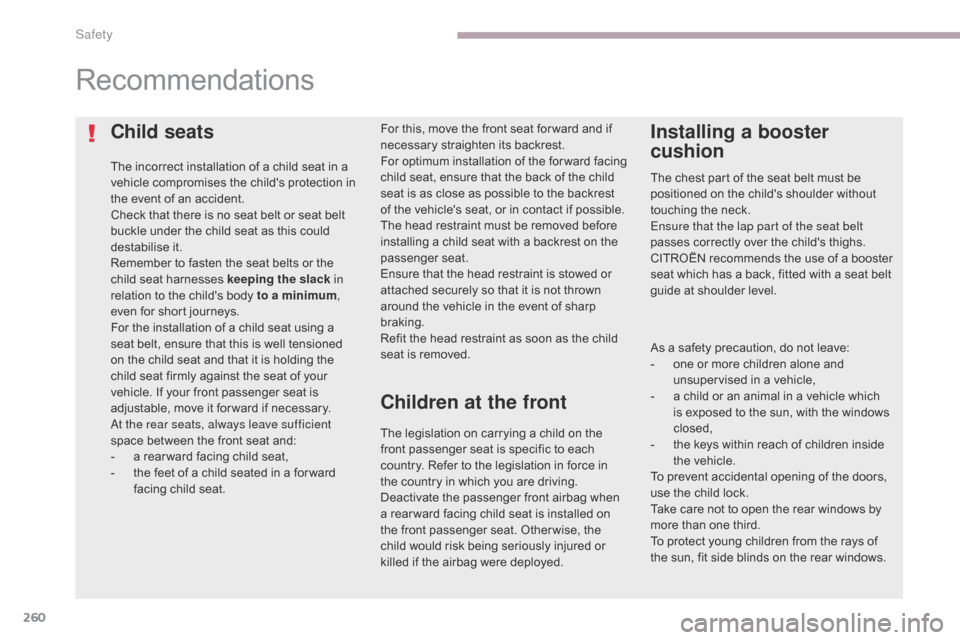
260
C4-Picasso-II_en_Chap06_securite_ed02-2016
Child seats
The incorrect installation of a child seat in a
vehicle compromises the child's protection in
the event of an accident.
Check that there is no seat belt or seat belt
buckle under the child seat as this could
destabilise it.
Remember to fasten the seat belts or the
child seat harnesses keeping the slack in
relation to the child's body to a minimum,
even for short journeys.
For the installation of a child seat using a
seat belt, ensure that this is well tensioned
on the child seat and that it is holding the
child seat firmly against the seat of your
vehicle. If your front passenger seat is
adjustable, move it for ward if necessary.
At the rear seats, always leave sufficient
space between the front seat and:
-
a r
ear ward facing child seat,
-
t
he feet of a child seated in a for ward
facing child seat.
Recommendations
For this, move the front seat for ward and if
necessary straighten its backrest.
For optimum installation of the forward facing
child seat, ensure that the back of the child
seat is as close as possible to the backrest
of the vehicle's seat, or in contact if possible.
The head restraint must be removed before
installing a child seat with a backrest on the
passenger seat.
Ensure that the head restraint is stowed or
attached securely so that it is not thrown
around the vehicle in the event of sharp
braking.
Refit the head restraint as soon as the child
seat is removed.Installing a booster
cushion
As a safety precaution, do not leave:
- o ne or more children alone and
unsupervised in a vehicle,
-
a c
hild or an animal in a vehicle which
is exposed to the sun, with the windows
closed,
-
t
he keys within reach of children inside
the vehicle.
To prevent accidental opening of the doors,
use the child lock.
Take care not to open the rear windows by
more than one third.
To protect young children from the rays of
the sun, fit side blinds on the rear windows. The chest part of the seat belt must be
positioned on the child's shoulder without
touching the neck.
Ensure that the lap part of the seat belt
passes correctly over the child's thighs.
CITROËN recommends the use of a booster
seat which has a back, fitted with a seat belt
guide at shoulder level.
The legislation on carrying a child on the
front passenger seat is specific to each
country. Refer to the legislation in force in
the country in which you are driving.
Deactivate the passenger front airbag when
a rear ward facing child seat is installed on
the front passenger seat. Otherwise, the
child would risk being seriously injured or
killed if the airbag were deployed.
Children at the front
Safety
Page 263 of 527
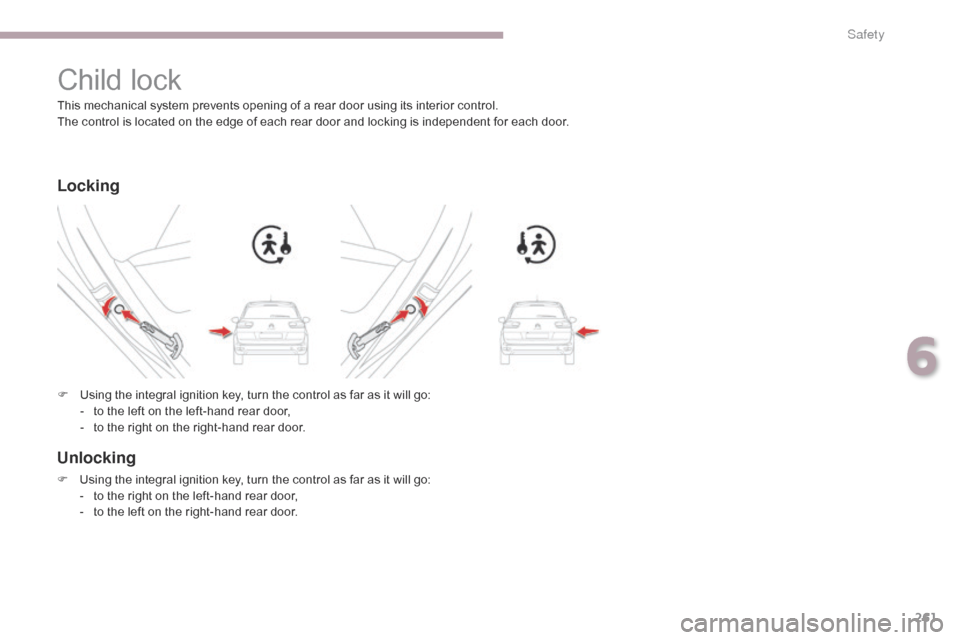
261
C4-Picasso-II_en_Chap06_securite_ed02-2016
Child lock
This mechanical system prevents opening of a rear door using its interior control.
The control is located on the edge of each rear door and locking is independent for each door.
F
U
sing the integral ignition key, turn the control as far as it will go:
-
t
o the left on the left-hand rear door,
-
t
o the right on the right-hand rear door.
Unlocking
F Using the integral ignition key, turn the control as far as it will go:- t o the right on the left-hand rear door,
-
t
o the left on the right-hand rear door.
Locking
6
Safety
Page 264 of 527
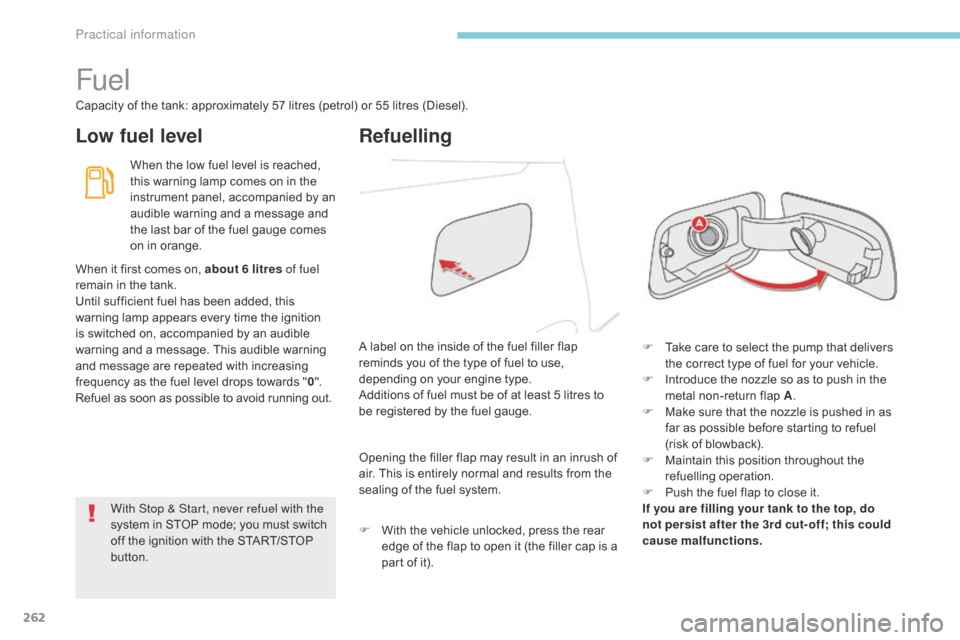
262
C4-Picasso-II_en_Chap07_info-pratiques_ed02-2016
Fuel
Capacity of the tank: approximately 57 litres (petrol) or 55 litres (Diesel).
Low fuel levelRefuelling
When the low fuel level is reached,
this warning lamp comes on in the
instrument panel, accompanied by an
audible warning and a message and
the last bar of the fuel gauge comes
on in orange.
F
T
ake care to select the pump that delivers
the correct type of fuel for your vehicle.
F
I
ntroduce the nozzle so as to push in the
metal non-return flap A .
F
M
ake sure that the nozzle is pushed in as
far as possible before starting to refuel
(risk of blowback).
F
M
aintain this position throughout the
refuelling operation.
F
P
ush the fuel flap to close it.
If you are filling your tank to the top, do
not persist after the 3rd cut- off; this could
cause malfunctions.
A label on the inside of the fuel filler flap
reminds you of the type of fuel to use,
depending on your engine type.
Additions of fuel must be of at least 5 litres to
be registered by the fuel gauge.
When it first comes on, about 6 litres of fuel
remain in the tank.
Until sufficient fuel has been added, this
warning lamp appears every time the ignition
is switched on, accompanied by an audible
warning and a message. This audible warning
and message are repeated with increasing
frequency as the fuel level drops towards "
0".
Refuel as soon as possible to avoid running out.
Opening the filler flap may result in an inrush of
air. This is entirely normal and results from the
sealing of the fuel system.
F
W
ith the vehicle unlocked, press the rear
edge of the flap to open it (the filler cap is a
part of it).
With Stop & Start, never refuel with the
system in STOP mode; you must switch
off the ignition with the START/STOP
button.
Practical information
Page 265 of 527
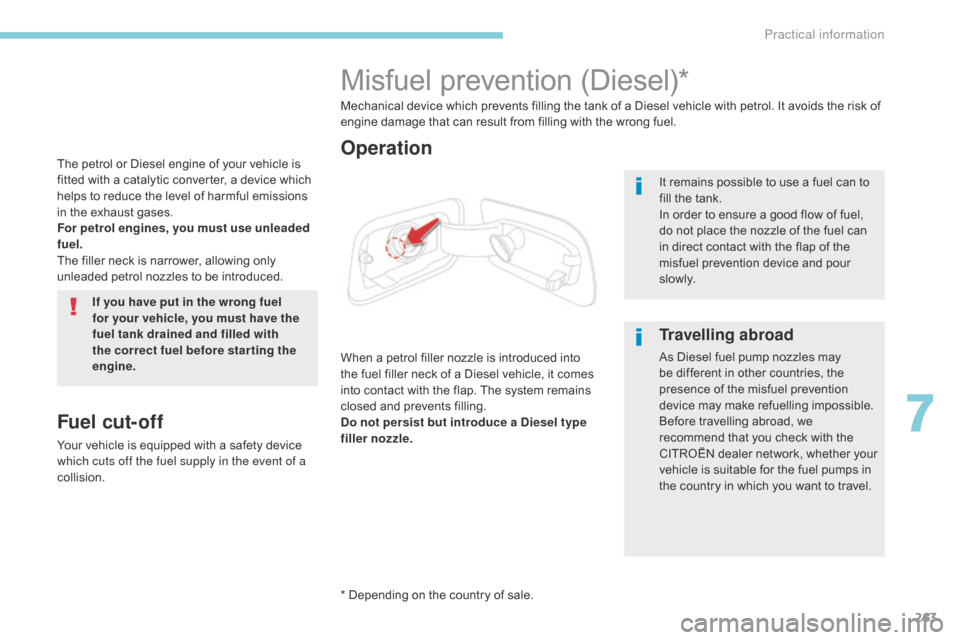
263
C4-Picasso-II_en_Chap07_info-pratiques_ed02-2016
The petrol or Diesel engine of your vehicle is
fitted with a catalytic converter, a device which
helps to reduce the level of harmful emissions
in the exhaust gases.
For petrol engines, you must use unleaded
fuel.
The filler neck is narrower, allowing only
unleaded petrol nozzles to be introduced.If you have put in the wrong fuel
for your vehicle, you must have the
fuel tank drained and filled with
the correct fuel before star ting the
engine.
Fuel cut- of f
Your vehicle is equipped with a safety device
which cuts off the fuel supply in the event of a
collision.
Misfuel prevention (Diesel)*
When a petrol filler nozzle is introduced into
the fuel filler neck of a Diesel vehicle, it comes
into contact with the flap. The system remains
closed and prevents filling.
Do not persist but introduce a Diesel type
filler nozzle. Mechanical device which prevents filling the tank of a Diesel vehicle with petrol. It avoids the risk of
engine damage that can result from filling with the wrong fuel.
It remains possible to use a fuel can to
fill the tank.
In order to ensure a good flow of fuel,
do not place the nozzle of the fuel can
in direct contact with the flap of the
misfuel prevention device and pour
s l ow l y.
Travelling abroad
As Diesel fuel pump nozzles may
be different in other countries, the
presence of the misfuel prevention
device may make refuelling impossible.
Before travelling abroad, we
recommend that you check with the
CITROËN dealer network, whether your
vehicle is suitable for the fuel pumps in
the country in which you want to travel.
* Depending on the country of sale.
Operation
7
Practical information
Page 266 of 527
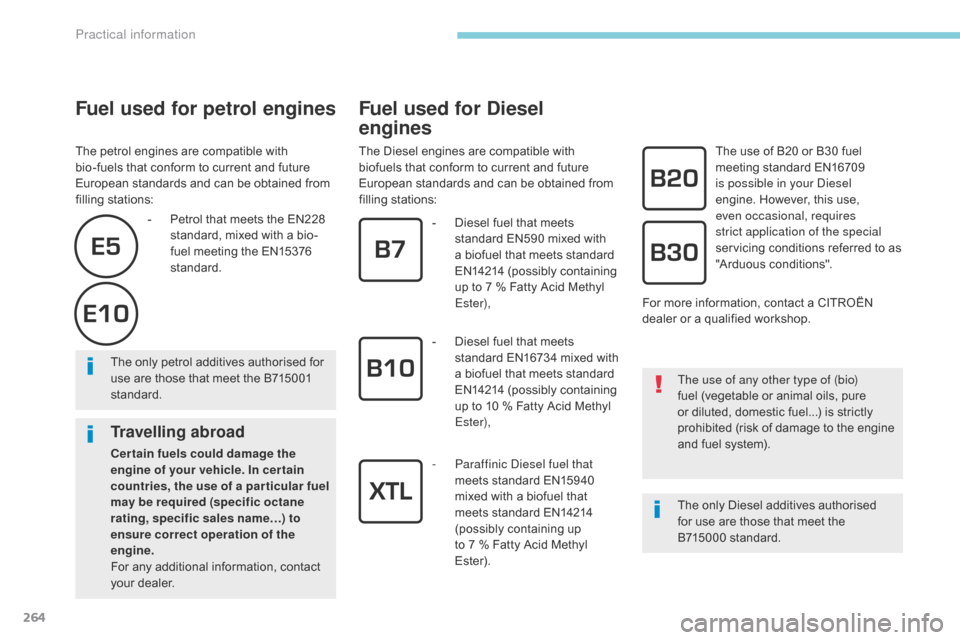
264
C4-Picasso-II_en_Chap07_info-pratiques_ed02-2016
Fuel used for petrol engines
The petrol engines are compatible with
bio-fuels that conform to current and future
European standards and can be obtained from
filling stations:
Fuel used for Diesel
engines
The Diesel engines are compatible with
biofuels that conform to current and future
European standards and can be obtained from
filling stations:The use of B20 or B30 fuel
meeting standard EN16709
is possible in your Diesel
engine. However, this use,
even occasional, requires
strict application of the special
servicing conditions referred to as
"Arduous conditions".
The use of any other type of (bio)
fuel (vegetable or animal oils, pure
or diluted, domestic fuel...) is strictly
prohibited (risk of damage to the engine
and fuel system).
The only Diesel additives authorised
for use are those that meet the
B715000
standard.
The only petrol additives authorised for
use are those that meet the B715001
standard.
-
Pe
trol that meets the EN228
standard, mixed with a bio-
fuel meeting the EN15376
standard.
Travelling abroad
Cer tain fuels could damage the
engine of your vehicle. In cer tain
countries, the use of a par ticular fuel
may be required (specific octane
rating, specific sales name…) to
ensure correct operation of the
engine.
For any additional information, contact
your dealer. -
D
iesel fuel that meets
standard EN590 mixed with
a biofuel that meets standard
EN14214 (possibly containing
up to 7 % Fatty Acid Methyl
Ester),
-
D
iesel fuel that meets
standard EN16734 mixed with
a biofuel that meets standard
EN14214 (possibly containing
up to 10 % Fatty Acid Methyl
Ester),
- P araffinic Diesel fuel that
meets standard EN15940
mixed with a biofuel that
meets standard EN14214
(possibly containing up
to
7 % Fatty Acid Methyl
Ester). For more information, contact a CITROËN
dealer or a qualified workshop.
Practical information
Page 267 of 527
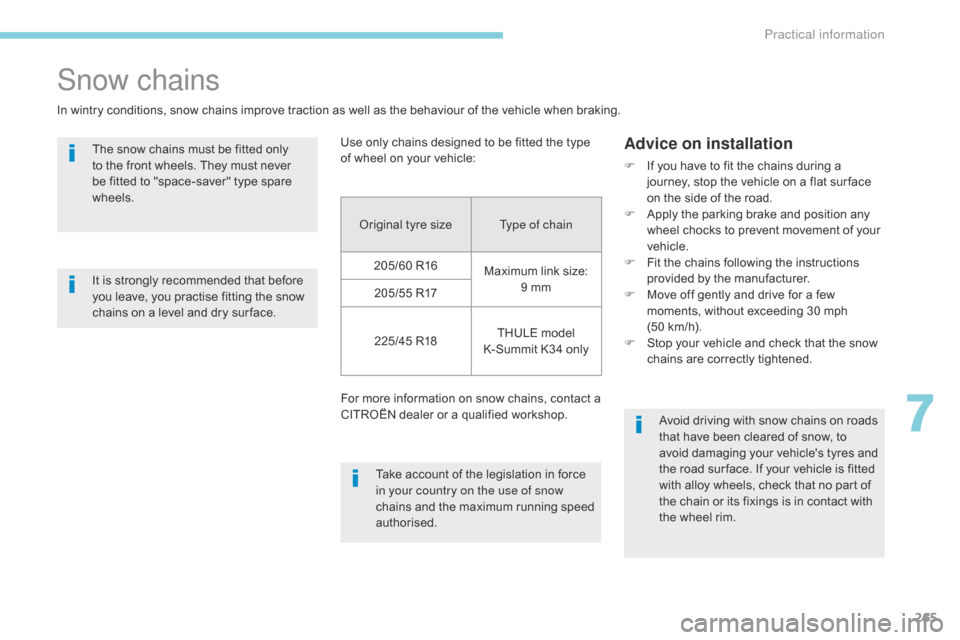
265
C4-Picasso-II_en_Chap07_info-pratiques_ed02-2016
Original tyre sizeType of chain
205/60 R16 Maximum link size:
9 mm
205/55 R17
225/45 R18 THULE model
K-Summit K34 only
For more information on snow chains, contact a
CITROËN dealer or a qualified workshop. Use only chains designed to be fitted the type
of wheel on your vehicle:
Snow chains
In wintry conditions, snow chains improve traction as well as the behaviour of the vehicle when braking. The snow chains must be fitted only
to the front wheels. They must never
be fitted to "space-saver" type spare
wheels.
Advice on installation
F If you have to fit the chains during a journey, stop the vehicle on a flat sur face
on the side of the road.
F
A
pply the parking brake and position any
wheel chocks to prevent movement of your
vehicle.
F
F
it the chains following the instructions
provided by the manufacturer.
F
M
ove off gently and drive for a few
moments, without exceeding 30 mph
(50
km/h).
F
S
top your vehicle and check that the snow
chains are correctly tightened.
Take account of the legislation in force
in your country on the use of snow
chains and the maximum running speed
authorised. Avoid driving with snow chains on roads
that have been cleared of snow, to
avoid damaging your vehicle's tyres and
the road sur face. If your vehicle is fitted
with alloy wheels, check that no part of
the chain or its fixings is in contact with
the wheel rim.
It is strongly recommended that before
you leave, you practise fitting the snow
chains on a level and dry sur face.
7
Practical information
Page 268 of 527
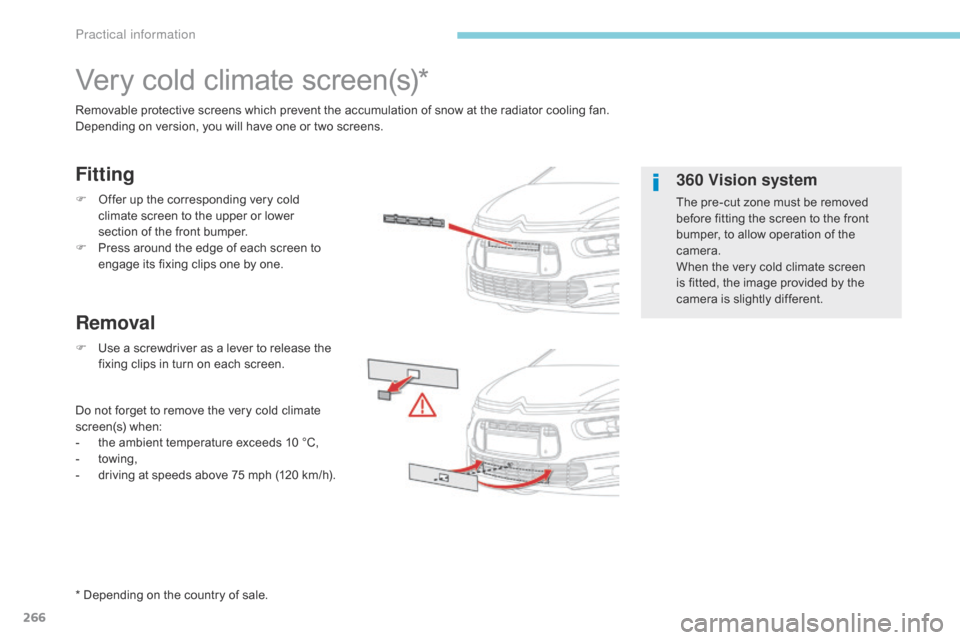
266
C4-Picasso-II_en_Chap07_info-pratiques_ed02-2016
Very cold climate screen(s)*
Removable protective screens which prevent the accumulation of snow at the radiator cooling fan.
Depending on version, you will have one or two screens.
F
O
ffer up the corresponding very cold
climate screen to the upper or lower
section of the front bumper.
F
P
ress around the edge of each screen to
engage its fixing clips one by one.
F
U
se a screwdriver as a lever to release the
fixing clips in turn on each screen.
Do not forget to remove the very cold climate
screen(s) when:
-
t
he ambient temperature exceeds 10 °C,
-
tow
ing,
-
d
riving at speeds above 75 mph (120
k
m/h).
Removal Fitting
360 Vision system
The pre-cut zone must be removed
before fitting the screen to the front
bumper, to allow operation of the
camera.
When the very cold climate screen
is fitted, the image provided by the
camera is slightly different.
*
Depending on the country of sale.
Practical information
Page 269 of 527
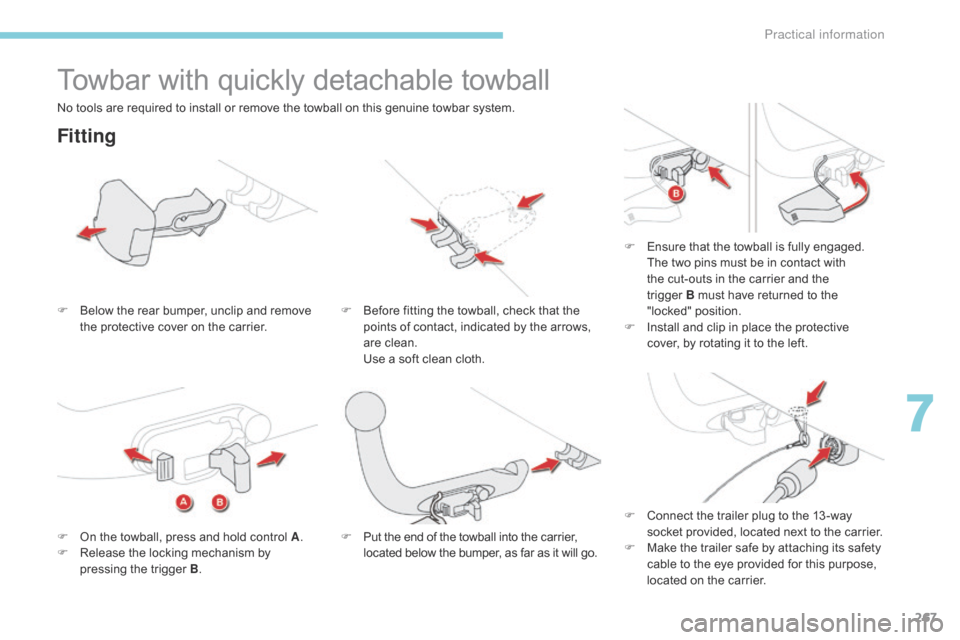
267
C4-Picasso-II_en_Chap07_info-pratiques_ed02-2016
Towbar with quickly detachable towball
Fitting
F Below the rear bumper, unclip and remove the protective cover on the carrier. F
B efore fitting the towball, check that the
points of contact, indicated by the arrows,
are clean.
U
se a soft clean cloth.F
E
nsure that the towball is fully engaged.
The two pins must be in contact with
the cut-outs in the carrier and the
trigger B must have returned to the
"locked" position.
F
I
nstall and clip in place the protective
cover, by rotating it to the left.
F
O
n the towball, press and hold control A .
F
R
elease the locking mechanism by
pressing the trigger B . F
P
ut the end of the towball into the carrier,
located below the bumper, as far as it will go.
No tools are required to install or remove the towball on this genuine towbar system.
F
C
onnect the trailer plug to the 13 -way
socket provided, located next to the carrier.
F
M
ake the trailer safe by attaching its safety
cable to the eye provided for this purpose,
located on the carrier.
7
Practical information
Page 270 of 527

268
C4-Picasso-II_en_Chap07_info-pratiques_ed02-2016
F Unclip and remove the protective cover, by turning it to the right.
Removing
F Press the trigger B and remove the towball by pulling it towards you.
F
O
n the towball, press and hold control A .
F
R
elease the locking mechanism by
pressing the trigger B . If the towball is not locked in place, the
trailer could separate. There is a risk of
an accident.
Always lock the towball in the way
described.
Observe the legislation in force in the
country in which you are driving.
Remove the towball when it is not being
used.
Before setting off, check that the trailer
lighting and signalling works correctly.
Maximum authorised nose weight:
70
kg.
For more information on your vehicle's
Weights , refer to the corresponding
section.
Carrying system (box or bicycle carrier).
You must not exceed the maximum
nose weight on the towbar: if this weight
is exceeded, the device could detach
from the vehicle and cause a serious
accident.
F
C
lip the protective cover in place on the
carrier located below the bumper.
Practical information